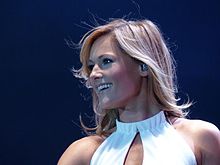Schlager music
| Schlager | |
|---|---|
| Stylistic origins | Original Subsequent: |
| Cultural origins | 1950s, West Germany,[1] East Germany and Austria |
| Subgenres | |
| Dansband | |
| Regional scenes | |
| Other topics | |
| Music of Germany | |
Schlager (German: [ˈʃlaːɡɐ], "hit(s)")[2] is a style of European popular music and radio format generally defined by catchy instrumental accompaniments to vocal pieces of pop music with simple, easygoing, and often sentimental lyrics.

Schlager tracks are typically light pop tunes or sweet, sentimental ballads with simple, catchy melodies. Their lyrics typically center on love, relationships, and feelings. The northern variant of schlager (notably in Finland) has taken elements from Finnic, Nordic, Slavic, and Eastern European folk songs, with lyrics tending toward melancholic and elegiac themes. Musically, schlager bears similarities to styles such as easy listening.[citation needed]
The style has been frequently represented at the Eurovision Song Contest and has been popular since the contest began in 1956,[2] though it is gradually being replaced by other pop music styles.
Etymology
[edit]Schlager is a loanword from German (from schlagen, "to hit"). It also came into some other languages (such as Bulgarian, Danish, Norwegian, Swedish, Dutch, Czech, Croatian, Finnish, Hungarian, Lithuanian, Latvian, Estonian, Serbian, Turkish, Russian,[3] Hebrew, and Romanian,[4] for example), where it retained its meaning of a "(musical) hit".
Central Europe
[edit]
The roots of German schlager are old. Originally, the word meant a hit or a strike. The first use of the word applied to music, in its original meaning, was in an opening night critique in the newspaper Wiener Fremden-Blatt on 17 February 1867 about The Blue Danube by Johann Strauss II.[5]
One ancestor of schlager music in its current meaning may be the operetta, which was highly popular in the early 20th century. In the 1920s and 1930s, the Comedian Harmonists and Rudi Schuricke laid the foundations for this new music.[6] Well-known schlager singers of the 1950s and early 1960s include Lale Andersen, Freddy Quinn, Ivo Robić, Gerhard Wendland, Caterina Valente, Margot Eskens and Conny Froboess. Schlager reached a peak of popularity in Germany and Austria in the 1960s (featuring Peter Alexander and Roy Black) and the early 1970s. From the mid-1990s through the early 2000s, schlager also saw an extensive revival in Germany by, for example, Guildo Horn,[2] Dieter Thomas Kuhn, Michelle, and Petra Perle. Dance clubs would play a stretch of schlager titles during the course of an evening, and numerous new bands were formed specialising in 1970s schlager cover versions and newer material.

Some Germans view schlager as their country music, and American country and Tex-Mex music are both major elements in schlager culture. ("Is This the Way to Amarillo" is regularly played in schlager contexts, usually in the English-language original.)
Popular schlager singers include Michael Holm, Roland Kaiser, Hansi Hinterseer, Jürgen Drews, Andrea Berg, Heintje Simons, Helene Fischer, Nicole, Claudia Jung, Andrea Jürgens, Michelle, Kristina Bach, Marianne Rosenberg, Simone Stelzer, Daniela Alfinito, Semino Rossi, Vicky Leandros, Leonard, DJ Ötzi, Andreas Gabalier and more recently, Beatrice Egli.[7]
In Hamburg in the 2010s, Schlager fans still gathered annually by the hundreds of thousands,[8] dressing in 1970s clothing for street parades called "Schlager Move". The Schlager Move designation is also used for a number of smaller schlager music parties in several major German cities throughout the year.[9] (This revival is sometimes associated with kitsch and camp.) In the meantime, private radio has brought Schlager back to the radio. Schlager Radio is a station that broadcasts its program terrestrially in Germany via transmission towers on both FM and DAB+.[10]
Stylistically, schlager continues to influence German "party pop" or "party-schlager" (e.g. "Layla", 2022):[11] that is, music most often heard in après-ski bars and Majorcan mass discos. In the English-speaking world, the most popular group to have included elements of schlager in their style is probably ABBA, a band that mixed traditional Swedish music, schlager, and pop-rock to create their own sound.[12]
Finland
[edit]See also
[edit]- Schlager and Volksmusik
- Estrada (music genre)
- Levenslied, similar genre in the Netherlands
- Pimba, similar genre in Portugal
- Traditional pop
- Middle of the road
- Adult contemporary music
- Dance-pop
References
[edit]- ^ Creekmur, Corey K., and Linda Y. Mokdad. The International Film Musical. Edinburgh University Press, 2012.
- ^ a b c Raykoff, Ivan; Deam Tobin, Robert (2007). A Song for Europe: Popular Music and Politics in the Eurovision Song Contest. London England and Burlington, Vt. US: Ashgate Publishing, Ltd. pp. 37–58. ISBN 9780754658795.
- ^ Шлягер (Shlyager) in the Great Soviet Encyclopedia, 1969–1978 (in Russian)
- ^ "Dexonline". Dexonline.ro. Retrieved 8 July 2018.
- ^ Norbert Linke: Musik erobert die Welt. Wie die Wiener Familie Strauß die „Unterhaltungsmusik“ revolutionierte. Herold, Wien 1987, ISBN 3-7008-0361-3, S. 204.
- ^ Alsmann, Götz (8 May 2008). "Der Schlager hat sich selbst entmannt". Der Spiegel (in German). Retrieved 26 September 2015.
- ^ Entry at Schlagerguide, (in German)
- ^ ""Schlagermove" - Atlantic Alliance". Archive.today. 21 July 2012. Archived from the original on 21 July 2012. Retrieved 20 November 2018.
- ^ "Schlagermove - Home". Schlagermove.de. Retrieved 8 July 2018.
- ^ "Schlager Radio · Hör auf Dein Herz!". Schlager Radio (Original) (in German). 27 September 2024. Retrieved 30 September 2024.
- ^ Koch, Tanit; mattwithers (27 July 2022). "Germansplaining: The song of the silly season". The New European. Retrieved 10 October 2022.
- ^ Harrison, A., "Why are ABBA so popular?," BBC Online, 21 October 2014. Retrieved 5 August 2022.
External links
[edit] Media related to Schlager at Wikimedia Commons
Media related to Schlager at Wikimedia Commons
